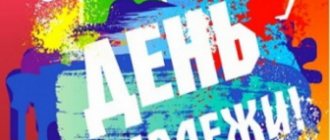Lesson of peace. Class hour for 8th grade. class hour (8th grade) on the topic
Class hour for the Holiday of Knowledge. 8th grade.
September meets us at the school threshold.
Goals:
1. Introduce the children to the history of the first day of school.
2. Set students up for the new school year.
3. Create a festive mood, a feeling of joy from meeting with school.
4. Conduct a fragment of the Peace lesson.
5. Introduce the children to the history of Sadako Sasaki and, in solidarity with the anti-war movement, make a paper crane.
6. Fostering feelings of patriotism.
Design and materials: class theme on the blackboard, multimedia projector, screen, presentation, origami paper.
Venue: classroom.
Teacher:
I want to tell you guys, if there were no beginning and end of the school year, the holidays would never bring you such joy. Everything, even very pleasant things, gradually becomes boring if it happens constantly. I know that for you the first of September is not a holiday, because you think that the time has come to work again. But if there is a beginning of the school year, then there will certainly be an end to the school year. And it will be a truly happy holiday. Therefore, you and I are celebrating the beginning of the school year, and you and I must work hard to complete it with dignity, and, of course, celebrate.
The Day of Knowledge holiday has its own history. Historians believe that its origins go back centuries. On the one hand, the date is associated with church canons. Byzantine theologians assumed that God began the creation of light on September 1. Plus, the harvest season ends in the fall. It is no coincidence that in ancient times Slavic farmers celebrated the New Year at this time.
A single start to the school year was introduced in the USSR in 1935. And in 1984, a decree was issued, in accordance with which September 1 officially became a holiday - the Day of Knowledge.
Now September 1 is a holiday for all schoolchildren, students and their parents. I congratulate you on this wonderful day.
Did you know that on September 1st, Peace lessons are often held in all schools.
Although Peace Day is celebrated on September 21, it was decided to focus on this event during the first days of school. Science is, first of all, creation, difficult and painstaking work for the benefit of all humanity, and it is for the sake of creation that children go to school.
September 21 - The UN General Assembly proclaimed the International Day of Peace as a day of general ceasefire and renunciation of violence.
This day should promote a ceasefire throughout the world, when all countries and peoples cease hostilities for the entire day, when all people observe a minute of silence at noon local time... The purpose of this day is to strengthen the ideals of peace both within the country and between nations.
Humanity must stop repeating the evil of children's lives being sacrificed and astronomical amounts of money being spent for the sake of war. The time has come when all countries of the world must use all their capabilities and set out on a campaign to establish peace. The world depends on our efforts.
I want to tell you the legend of 1000 cranes:
In Japan, paper cranes are considered a symbol of good luck and longevity.
There is a tradition based on a beautiful legend: “If you fold a thousand paper cranes with love and care, give them to those around you, and receive a thousand smiles in return, all your wishes will come true.”
Japanese girl Sadako Sasaki (January 7, 1943 - October 25, 1955), irradiated during the atomic bombing of Hiroshima on August 6, 1945. Her house was located a mile from the explosion, yet outwardly she continued to grow up as a healthy child. Signs of the disease appeared in November 1954, on February 18, 1955 he was diagnosed with leukemia, and on February 21 he was admitted to the hospital. According to doctors' forecasts, she had no more than a year to live. On August 3, 1955, her best friend Chizuko Hamamoto brought her a piece of golden paper and folded it into a crane, recalling the Japanese belief that a person who folds a thousand paper cranes will have his wish come true.
The legend influenced Sadako, and she began to fold cranes from any pieces of paper that fell into her hands. According to the legend from the book “Sadako and the Thousand Paper Cranes”, she managed to make only 644 cranes. Her friends finished their work and Sadako was buried along with a thousand paper cranes.
A monument was built in memory of Sadako and all the other children who died from the atomic bombing. Young people from all over Japan raised funds for this project, and in 1958 a statue depicting Sadako holding a paper crane was erected in the Peace Park in Hiroshima. On the pedestal of the statue is written: “This is our cry. This is our prayer. World peace". The little courageous girl became a symbol of rejection of nuclear war, a symbol of protest against war.
I suggest you also make a crane and join the people who are against the war.
Conclusion
Congratulations, dear guys, on your holiday! I am sure that the new school year will be a time of great success and brilliant victories for you, that together we will realize the most daring ideas and plans, and this school year will bring everyone a lot of new emotions, creative energy and success!
I wish you good health and prosperity! Happy Knowledge Day, friends!
Good luck!
Application:
— photograph of the monument to Sadako Sasaki in Japan
- paper crane diagram
Monument to Sadako Sasaki in Japan
Paper crane diagram


